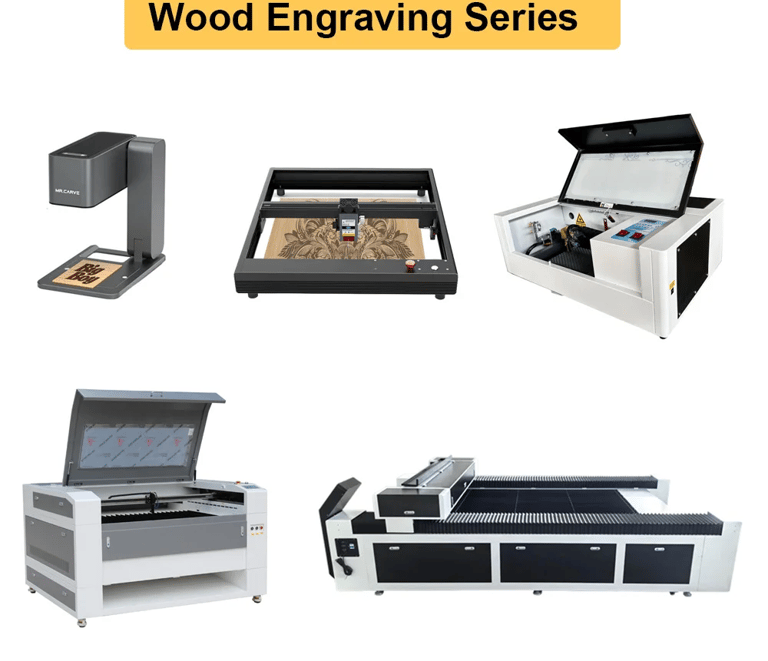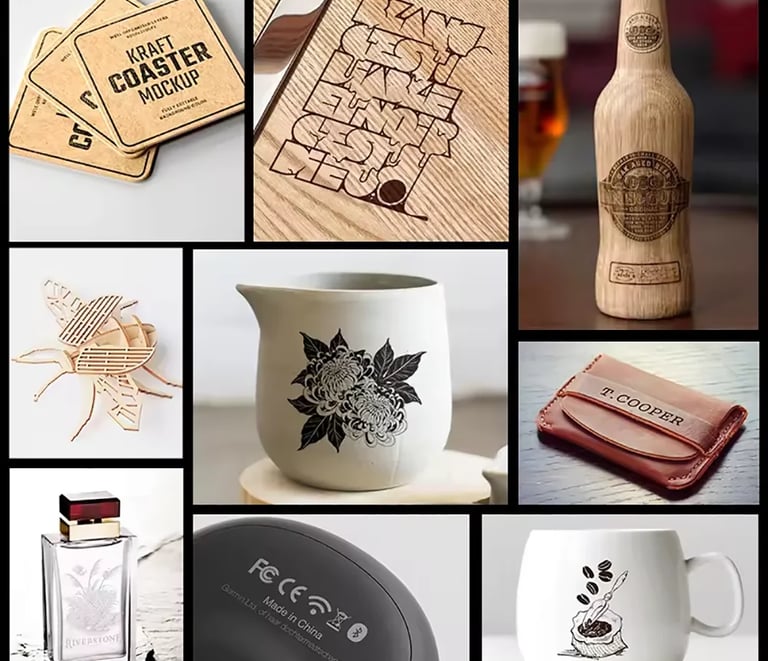The Ultimate Guide to Wood Laser Cutting and Engraving: Transforming Wood with Precision and Creativity
HOME SUPPLIES
10/6/20245 min read


Exploring the World of Wood Laser Cutting and Engraving
Laser cutting and engraving technology has revolutionized industries ranging from manufacturing to crafts. Wood laser cutting, in particular, has gained significant popularity due to its versatility and precision. Whether you're a hobbyist or a professional, the ability to work with various types of wood—alongside its customization options—opens up endless possibilities. But what exactly is wood laser cutting, and why is it such a game-changer? Let’s dive into the details.
What is Wood Laser Cutting?
Laser cutting refers to the process of using a laser to cut materials, including wood, with extreme precision. This technique utilizes a focused beam of light to melt, burn, or vaporize the material. Unlike traditional cutting methods, which often result in rough edges and irregularities, laser cutting produces clean, sharp cuts with no need for further finishing.
Benefits of Laser Cutting Wood
Precision and Accuracy
Laser cutting offers remarkable accuracy, ensuring that every cut is perfectly aligned with the design. This precision is crucial for intricate patterns, such as those required in custom wood items or intricate laser engravings.No Contact with the Material
Since lasers don’t physically touch the material, there's less risk of warping or distortion, unlike mechanical cutting methods that can apply pressure.Versatility in Design
Laser cutting allows for the creation of complex and detailed designs that would be almost impossible to achieve with traditional cutting tools. From custom wood art to wooden toys, the possibilities are endless.Efficiency and Speed
Laser machines operate swiftly, cutting through wood quickly without compromising on quality. For businesses, this means faster turnaround times and the ability to scale production.Minimal Waste
Lasers are highly efficient in their use of material. The cuts are precise and clean, leaving minimal leftover material, which is ideal for both environmental sustainability and cost-effectiveness.
Types of Wood Suitable for Laser Cutting and Engraving
When choosing wood for laser cutting, it’s essential to understand the characteristics of different types of wood. Some woods are more suitable for laser cutting, while others work better for engraving.
Basswood
Basswood is a popular choice due to its softness, light color, and fine grain, which allows for clean, smooth cuts and engravings. It's ideal for both beginners and advanced users.Birch Plywood
Birch plywood is widely used in laser cutting because it has a consistent grain pattern, which makes it perfect for both cutting and engraving. It is also relatively inexpensive and readily available.Maple and Oak
These hardwoods are known for their durability and beautiful grain patterns. They are suitable for laser engraving, especially when creating items like wooden photo frames, furniture, and jewelry.MDF (Medium Density Fiberboard)
MDF is a smooth, dense wood material that cuts easily with a laser. It’s often used for creating architectural models, signs, and decorative pieces.Plywood
Plywood is a multi-layered material that offers both strength and flexibility. It's ideal for larger projects, such as laser-cut furniture or custom architectural elements.
The Laser Cutting Process: Step-by-Step
Design Creation
The first step in laser cutting is to create the design you want to cut. This can be done using vector graphics software like Adobe Illustrator, CorelDRAW, or even CAD software. The design is then converted into a format that the laser cutting machine can read.Material Setup
Once the design is ready, the wood is placed onto the laser bed. Properly securing the material is essential to prevent shifting during cutting, which could distort the final product.Laser Cutting
The laser beam is focused on the material, and the laser cutter follows the outline of the design. For thicker woods, multiple passes may be necessary to cut through the material completely.Post-Processing
After the cutting is complete, the piece may need some finishing touches, such as cleaning the cut edges or removing any soot marks left by the laser. For engraving, the process typically results in minimal cleanup.
Laser Engraving vs. Laser Cutting: What's the Difference?
While both laser cutting and laser engraving utilize the same technology, the processes and results are quite different.
Laser Cutting
Laser cutting removes material, creating separate parts or holes in the material. It’s typically used for cutting shapes, intricate designs, and patterns.Laser Engraving
Laser engraving, on the other hand, involves etching or burning the surface of the material to create a design. It does not remove material but leaves a detailed mark, perfect for creating logos, names, and artwork.
Applications of Laser-Cut Wood Products
Laser-cut wood products have a wide array of applications. From decorative art pieces to functional items, the possibilities are vast.
Custom Wooden Gifts
Laser-cut wood makes for perfect personalized gifts, whether it’s a custom wooden box, photo frame, or Christmas ornament.Home Decor
Laser engraving and cutting can transform your home with intricate wooden wall art, laser-cut lamps, and wooden sculptures.Toys and Games
Laser cutting is ideal for crafting wooden toys, such as puzzles and building blocks, as it allows for precise, safe cuts.Business Branding
Businesses often use laser cutting to create custom signage, promotional items, and even branded gifts that showcase their logo in beautiful detail.Jewelry and Accessories
Laser cutting and engraving are used to create unique wooden jewelry items such as earrings, pendants, and bracelets.
Choosing the Right Laser Cutting Machine for Wood
When selecting a laser cutting machine for wood, there are several factors to consider. Here’s a guide to help you choose the right machine for your needs:
Power
The power of the laser cutter is an important consideration. Machines typically range from 3W to 150W, with more powerful machines able to cut through thicker materials. For thin wood like plywood, 5W to 10W machines are usually sufficient.Size
Consider the size of the material you’ll be cutting. Machines are available in different sizes, ranging from small desktop models for hobbyists to large industrial models capable of handling larger sheets of wood.Type of Laser
CO2 lasers are the most common for wood cutting. They are capable of cutting and engraving with high precision, making them suitable for various wood types.Software Compatibility
Make sure the laser cutting machine is compatible with the design software you use. Many laser cutters work well with programs like AutoCAD, CorelDRAW, and Illustrator.
Laser Cutting Service for Wood: When to Consider Outsourcing
If you don’t own a laser cutting machine or need high-volume cutting, outsourcing to a professional laser cutting service might be the best solution. These services often have larger, more powerful machines that can handle a wide range of materials. Additionally, they offer expertise in material selection, design optimization, and post-processing.
Conclusion: The Future of Wood Laser Cutting and Engraving
Laser cutting and engraving have undoubtedly transformed the woodworking industry. With precise, clean cuts and the ability to work with a variety of woods, this technology allows for endless creative possibilities. Whether you're crafting personalized gifts or large-scale furniture, the precision and efficiency of laser cutting are unbeatable.
As the technology continues to evolve, so too will the applications for laser-cut wood. With the right machine, wood, and design, the possibilities are limitless. So, what will you create with your laser cutter?


